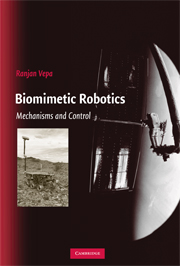Book contents
- Frontmatter
- Contents
- Preface
- Acronyms
- 1 The Robot
- 2 Biomimetic Mechanisms
- 3 Homogeneous Transformations and Screw Motions
- 4 Direct Kinematics of Serial Robot Manipulators
- 5 Manipulators with Multiple Postures and Compositions
- 6 Grasping: Mechanics and Constraints
- 7 Jacobians
- 8 Newtonian, Eulerian, and Lagrangian Dynamics
- 9 Path Planning, Obstacle Avoidance, and Navigation
- 10 Hamiltonian Systems and Feedback Linearization
- 11 Robot Control
- 12 Biomimetic Motive Propulsion
- Answers to Selected Exercises
- Appendix: Attitude and Quaternions
- Bibliography
- Index
12 - Biomimetic Motive Propulsion
Published online by Cambridge University Press: 20 February 2010
- Frontmatter
- Contents
- Preface
- Acronyms
- 1 The Robot
- 2 Biomimetic Mechanisms
- 3 Homogeneous Transformations and Screw Motions
- 4 Direct Kinematics of Serial Robot Manipulators
- 5 Manipulators with Multiple Postures and Compositions
- 6 Grasping: Mechanics and Constraints
- 7 Jacobians
- 8 Newtonian, Eulerian, and Lagrangian Dynamics
- 9 Path Planning, Obstacle Avoidance, and Navigation
- 10 Hamiltonian Systems and Feedback Linearization
- 11 Robot Control
- 12 Biomimetic Motive Propulsion
- Answers to Selected Exercises
- Appendix: Attitude and Quaternions
- Bibliography
- Index
Summary
Introduction
In this chapter we consider some important benchmark problems involving biomimetic robots, such as the dynamics and balance of walking biped robots, dynamics and control of four-legged robotic vehicles, dynamics and control of robotic manipulators in free flight, dynamics and control of flapping propulsion in aerial vehicles, and the underwater propulsion of aquatic vehicles.
Dynamics and Balance of Walking Biped Robots
The dynamics and control of walking bipeds provides much insight into biomimetic robots. We consider a relatively simple model of a walking model that is capable of capturing the principal features of the kinematics and dynamics of coordinating walking that resemble a human gait. Generally a human can be modeled to operate in two-dimensional space, with the model having a head, a pair of arms attached by a shoulder joint to a torso, and two identical legs with knees as well as two ankles and feet. Such a model is capable of demonstrating uniform walking based on the stance and swing mechanism, dynamic balance of the torso and the head, the role of the ankle and feet in providing rolling contact with ground, and the role of the human arms that act as “stabilizers” while the robot is walking forward with uniform forward velocity. Such a planar model is illustrated in Figure 12.1.
Dynamic Model for Walking
To understand the basic kinematics of coordinated walking, a simplified seven-DOF model involving the head, torso, and legs is adequate. The legs by themselves form a classical five-bar linkage, and when the constraint of a single-leg support is included, the number of DOFs is reduced to just five.
- Type
- Chapter
- Information
- Biomimetic RoboticsMechanisms and Control, pp. 272 - 308Publisher: Cambridge University PressPrint publication year: 2009

